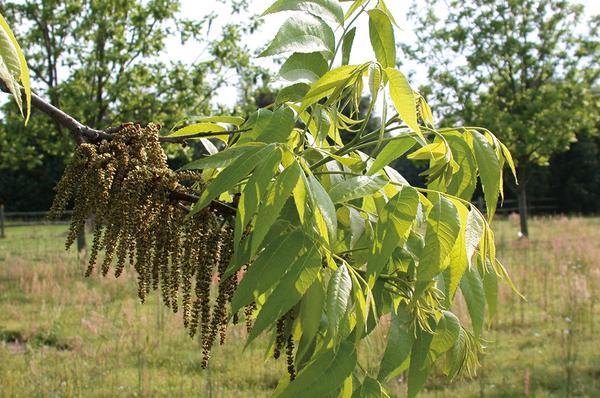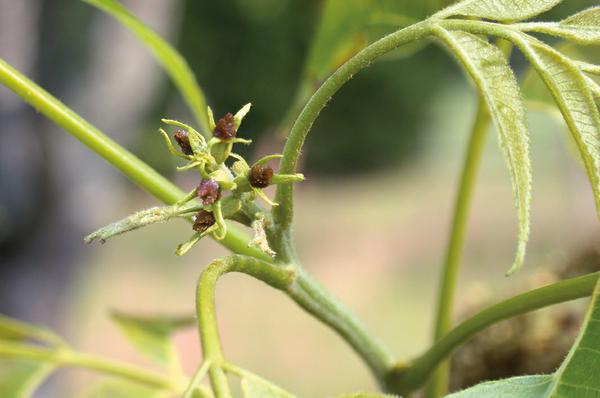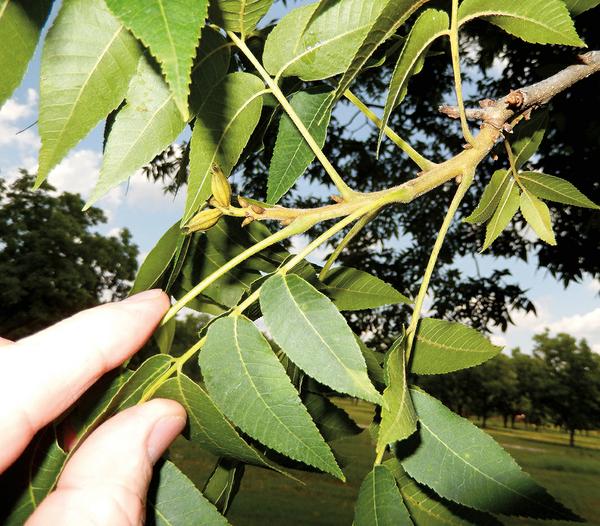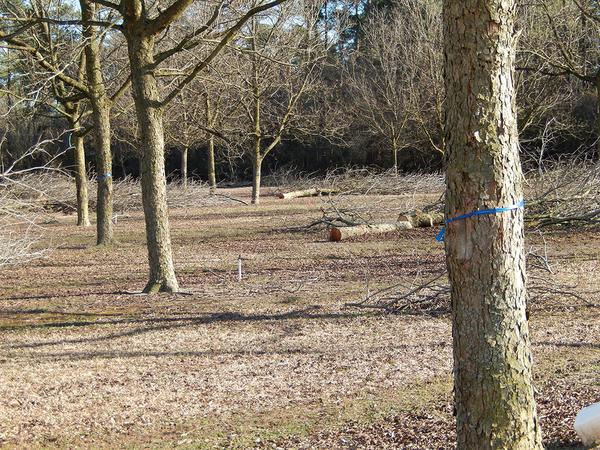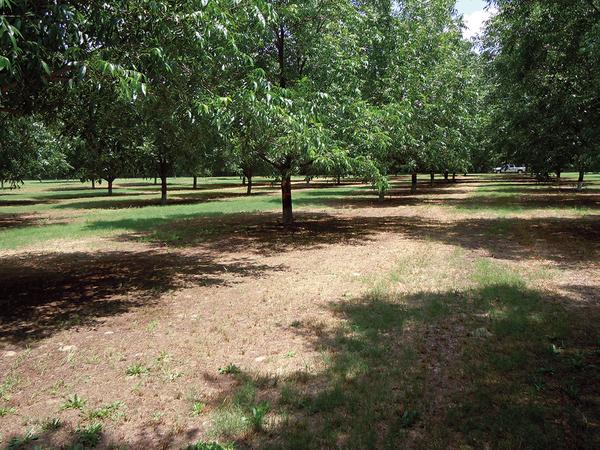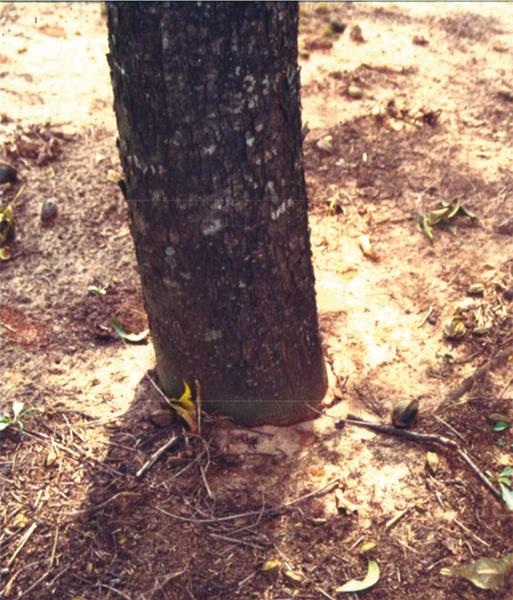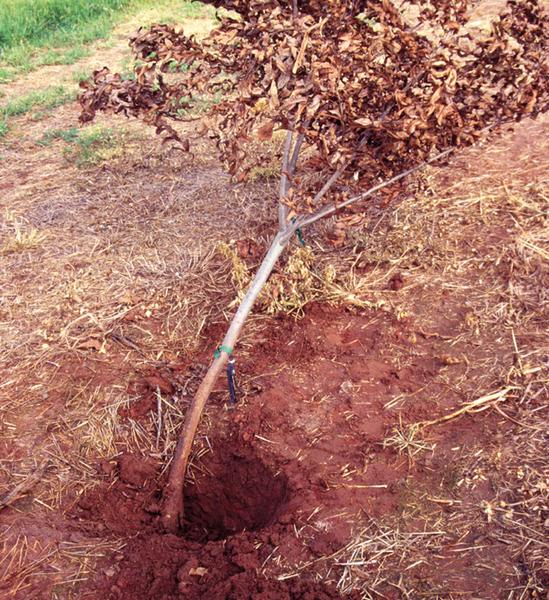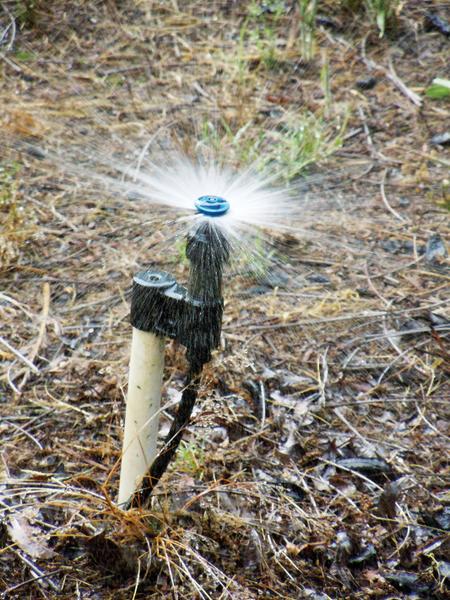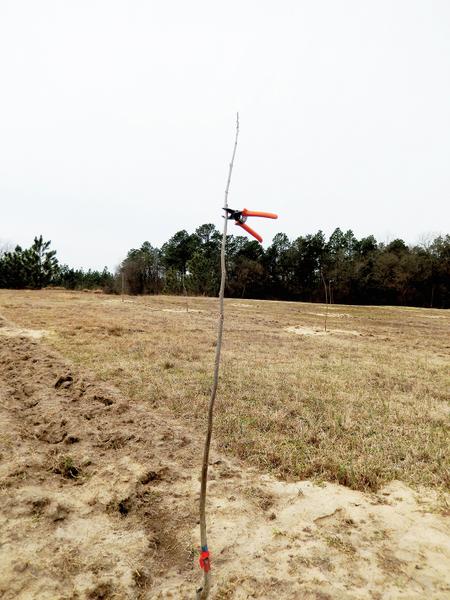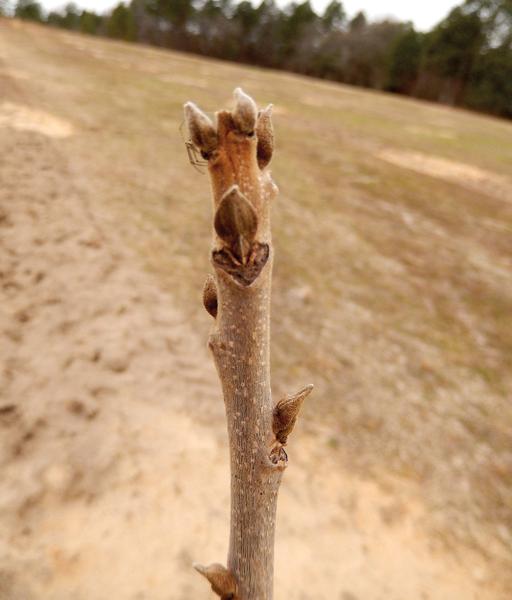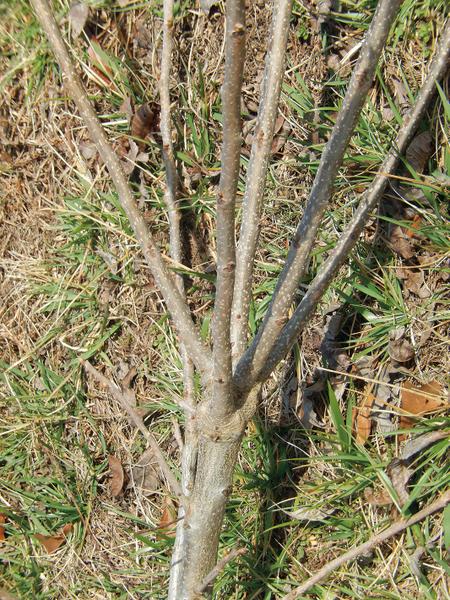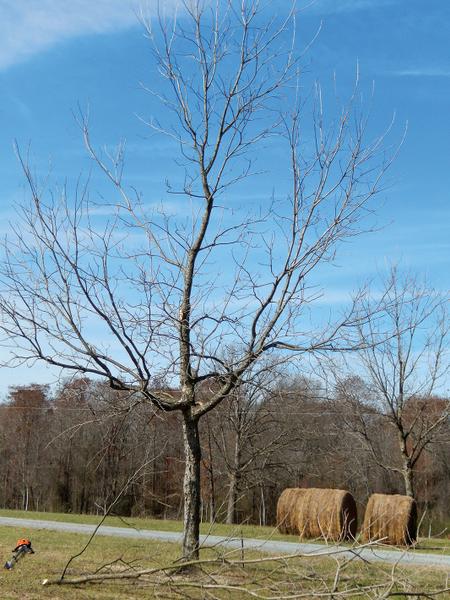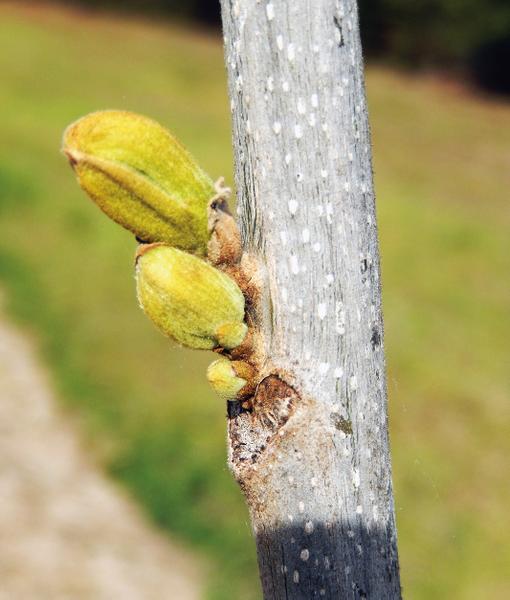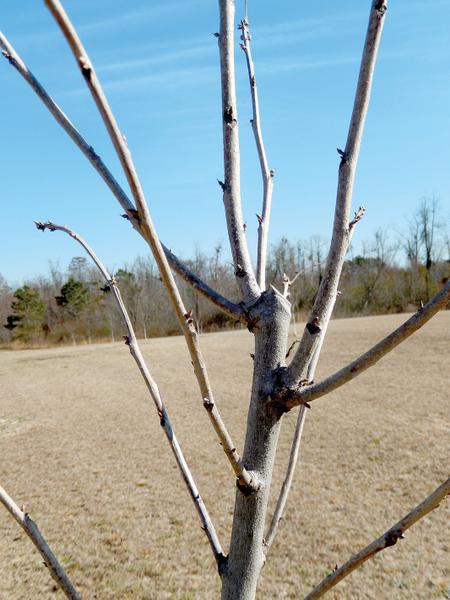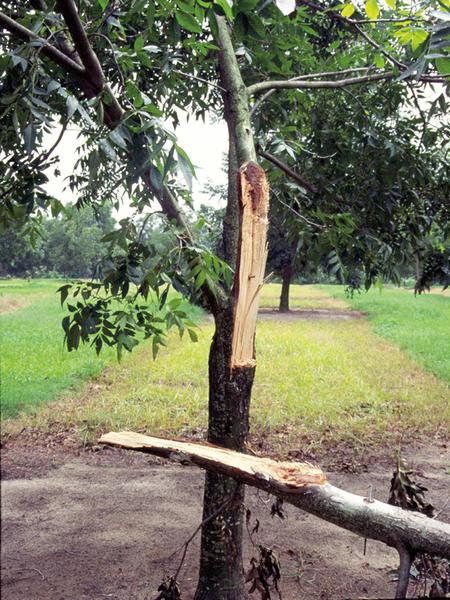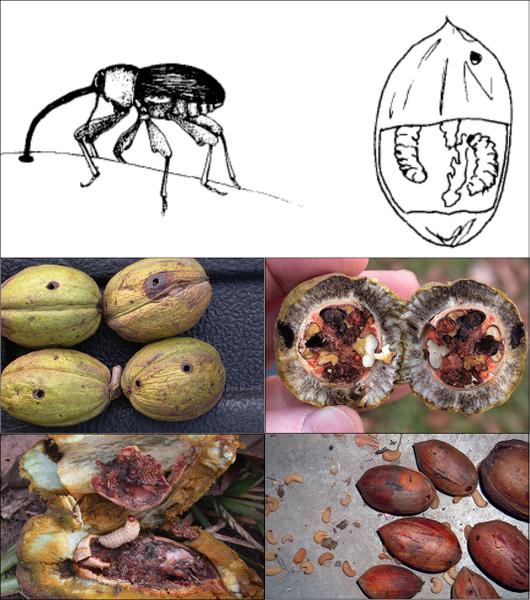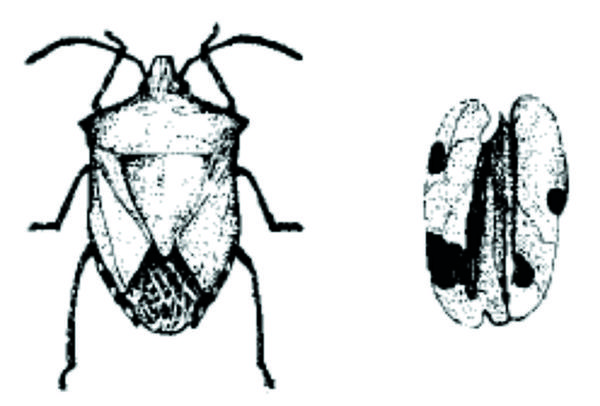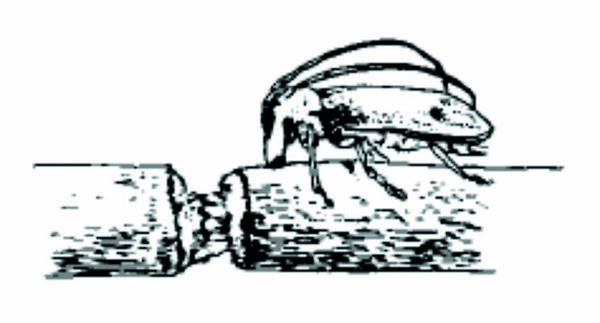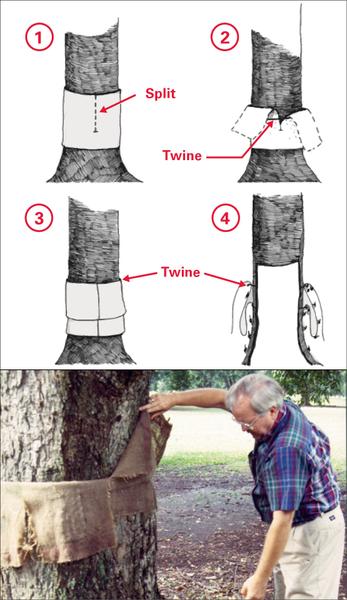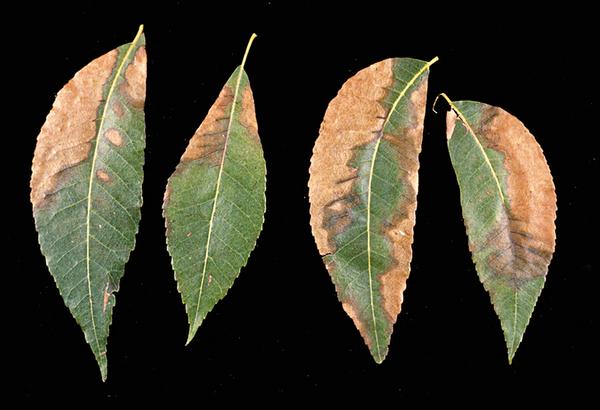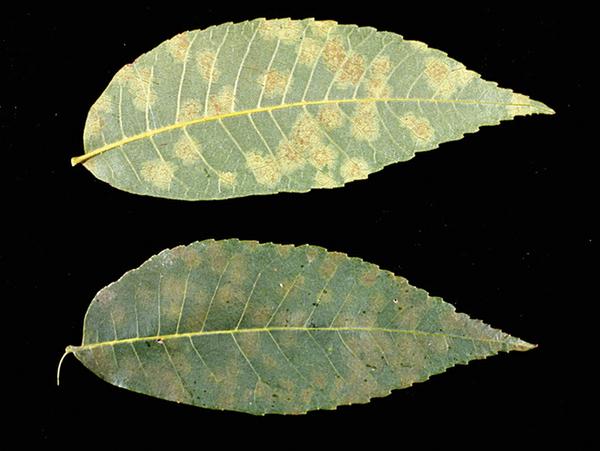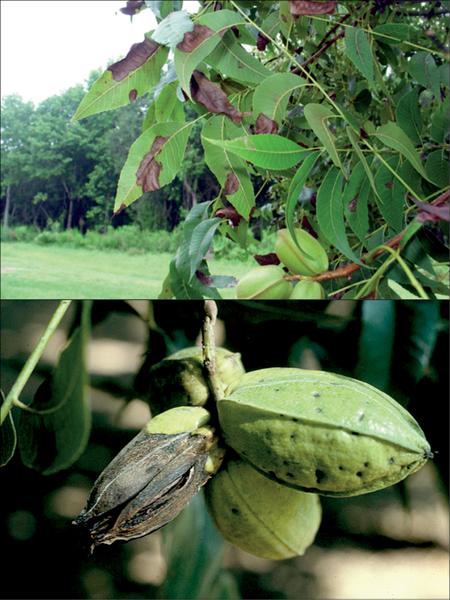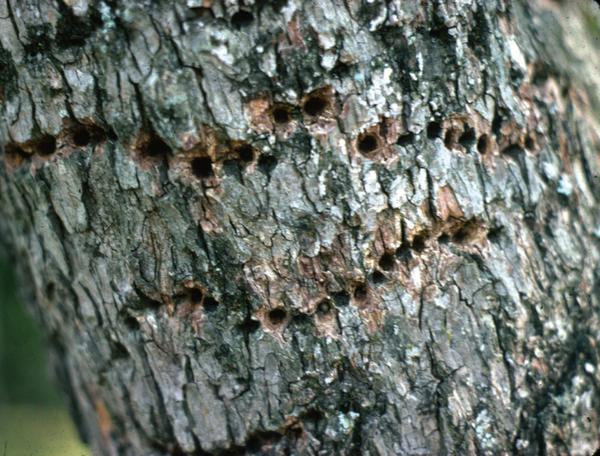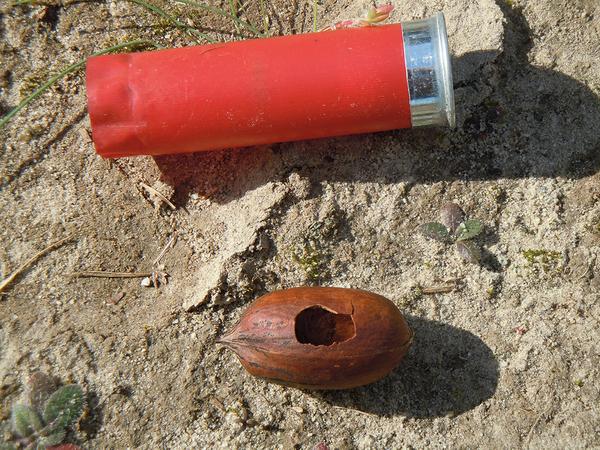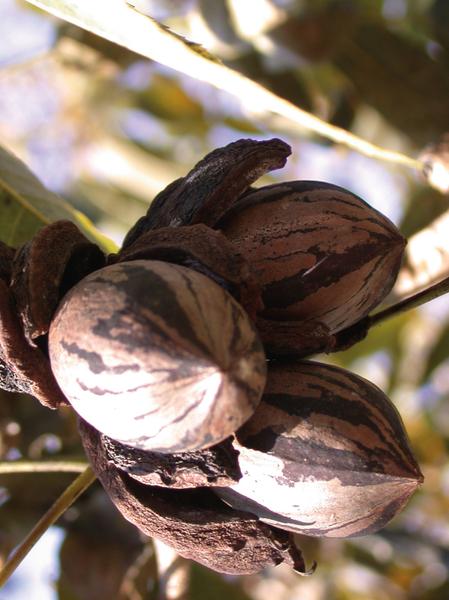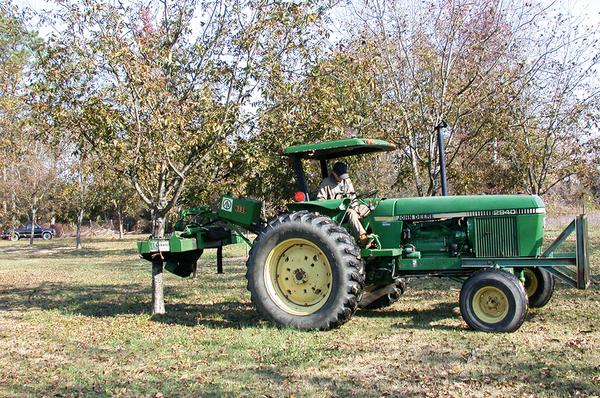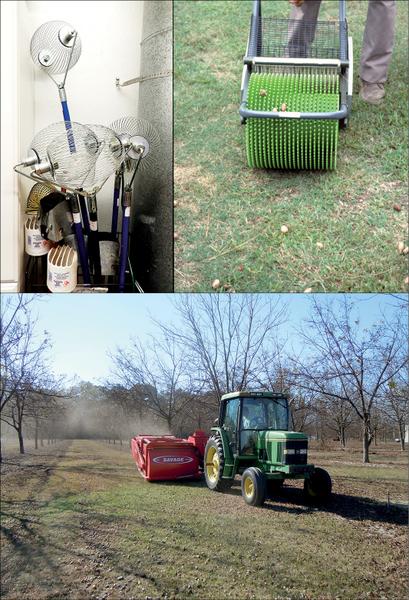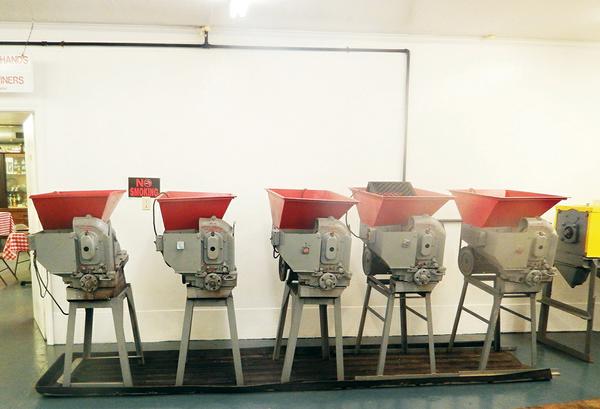For many generations, pecans have been grown on family homesteads in North Carolina for both food and profit. Today, pecans are still grown in North Carolina for income and enjoyment, predominately in the southeastern part of the state. Growing pecans requires patience and a long-term commitment. Pecan trees, however, can grow and produce quality nuts for decades with some effort and expense. There are commercial pecan plantings in North Carolina well over 75 years old and still very productive. In years when a full crop is produced, North Carolina produces more than 5 to 6 million pounds. The size of production ranges from several trees in the backyard to commercial orchards with 30 or more acres. Plantings of 20 to 30 trees are common. Whether you own a few trees or a commercial orchard, growing pecans can be enjoyable as well as profitable. As with any venture, however, planning is essential. In this publication, we explain some of the keys to successfully growing pecans.
Selecting a Site
North Carolina is on the northern fringe of the commercial improved pecan-producing region of the United States. The limiting factor is the length of the growing season. The probability of spring frost damage to early and midseason varieties and the limited selection of late-maturing varieties for North Carolina are both limitations of pecan production. North Carolina’s northern-fringe location makes proper site and varietal selection crucial for consistent, profitable production.
Pecans do not grow well in all areas of the state. The best area is the North Carolina coastal plain, extending to the eastern edge of the North Carolina piedmont. Although pecan trees can be grown further west, nut production may be inconsistent.
The selected site should ideally have well-drained, deep soils (3 to 4 feet) with moderate soil-moisture-holding capacity. Pecan trees are native to river valley soils and have a relatively high water requirement. They do best on sandy loam soils but also can be grown on heavier soils such as clay loams if the soils are well-drained. In areas where the soil is lighter and relatively dry, irrigation is required.
To reduce the potential for frost or freeze damage, select a site at a higher elevation or one on a gradual slope. Do not plant in low areas where cold air tends to settle; these areas are frequently referred to as frost pockets. As cold air settles, the moist air is frequently seen as fog or dew. Orchards planted on a slope also dry more quickly after wet periods, decreasing the wetting period of the orchard and minimizing conditions that favor disease development. Climatological maps can be used to determine potential sites for growing pecans. Information on the length of the season for a particular area, indicated by the number of frost-free growing days and the probability of frost in the spring, is readily available. For help with sites and season length, contact your county Cooperative Extension Center.
A site’s history is also a very good indicator of how well pecans will grow. Does the site frequently have frost in late spring or in early fall? Does it have standing water during wet periods, and is water readily available during very dry periods if irrigation is needed? What has been planted on this site in the last several years? Have herbicides or pesticides been used that may still be present in the soil? If so, will they reduce pecan tree growth when planted? Are pesticides or growth regulators applied to nearby fields that may harm pecan trees? Are homes or public areas nearby that might restrict spraying? All of these questions should be answered before you plant pecan trees.
Selecting Pecan Varieties
When selecting a pecan variety, consider pollination requirements, length of growing season, cold tolerance, and scab resistance. Table 1 lists the varieties that have the greatest potential for commercial success in North Carolina. All of the varieties listed have an appropriate growing season and adequate cold hardiness, and they are at least moderately resistant to scab, the primary pecan disease in the state.
Pollination requirements for pecan trees differ from all other tree fruit crops. Pecan trees are monoecious, which means that they have separate male and female structures on the same tree: catkins and flowers (Figure 1, Figure 2, Figure 3). The time at which the male catkins release pollen, however, is not the time at which the female flowers are receptive to pollination. Pecan trees are separated into two pollination groups referred to as Type I and Type II. Catkins on Type I (protandrous) trees release their pollen before the female flowers are receptive, and catkins on Type II (protogynous) trees release their pollen after the female flowers are receptive. Because of this difference, both Type I and Type II pecan trees are required for pollination. To ensure maximum pollination and production, select at least three varieties to be planted together. However, because of differences in disease susceptibility to pecan scab, planting as many different varieties of pecans as possible may help to minimize the potential pecan scab pressure and crop loss.
| Variety | Size (nuts/lb) | Percent Kernel | Scab Resistance | Fruit Bearing Age (years) |
Comments |
|---|---|---|---|---|---|
| TYPE I | |||||
| Pawnee | 56 | 54 | Moderate to Poor | 6 to 7 | Early maturing |
| Mandan*** | 49 | 57 | Good | Matures 1 week after Pawnee | |
| Lipan*** | 44 | 55 | High | Matures 2 weeks after Pawnee | |
| Caddo*** | 67 | 54 | Moderate | 5 to 6 | Black-aphid susceptible |
| Oconee*** | 48 | 53 | Moderate | 6 to 7 | Susceptible to shading |
| Amling*** | 57 | 55 | Excellent | Good choice for home use where trees cannot be sprayed in scab-prone areas | |
| Cape Fear | 55 | 51 | Good | 5 to 7 | A native North Carolina variety, prone to alternate bear and possibly susceptible to bacterial leaf scorch |
| TYPE II | |||||
| Lakota*** | 59 | 62 | High | Matures 2 weeks after Pawnee | |
| Kanza*** | 74 | 52 | High | Excellent cold hardiness and prone to alternate bear | |
| Chickasaw | 64 | 55 | Moderate | 5 to 6 | Kernels may be dark; severe alternate bearer* |
| Elliott | 71 | 53 | High | 7 to 9 | May be aphid-susceptible and prone to alternate bear |
| Stuart | 48 | 48 | Moderate to Poor | 8 to 10 | Major historic variety grown in North Carolina with marginal nut quality and poor filling in some years |
| Forkert | 53 | 58 | Moderate to Low | 5 to 6 | High nut quality and thinner shell |
| Gloria Grande | 48 | 48 | High | 7 to 9 | Very cold tolerant |
| Kiowa | 48 | 53 | Moderate | 5 to 6 | Prone to alternate bear and overcropping in alternate years; kernel is darker in color |
| Sumner | 56 | 49 | High to Moderate | 7 to 9 | Late maturing, which could be a problem in North Carolina |
| *Alternate bearing trees are prone to producing heavy crops every two to three years. ***Limited experience in North Carolina, but shows promise. |
|||||
Pecan Varieties Not Recommended for North Carolina
The following common varieties are not recommended for North Carolina because of their inability to tolerate the cold, the short growing season, or heavy pest susceptibility:
Desirable—cold sensitive, weak tree structure, and moderate to poor scab susceptibility
Mahan—nuts fill poorly, highly scab susceptible, and severe alternate bearer
Schley—low yielding, highly scab susceptible, and soft shells result in many vertebrate control problems
Success—variable nut quality but frequently poor quality, highly susceptible to scab, and severe alternate bearer
Planning and Establishing an Orchard
When pecan trees are fully mature, approximately 20 to 25 years after planting, tree spacing should be approximately 70 to 80 feet between rows and also between trees within rows, resulting in six to nine trees per acre. Alternative management systems that may be more economical and increase cash flow in pecan plantings during the initial years do warrant consideration here. Some growers have planted pecan trees in fields that are grazed by animals during the growing season. This practice, however, is not recommended for new plantings. There are several problems that occur with this approach: Ground covers planted up to the trunk of a pecan tree reduce tree growth and ultimately delay production, soil around the trees may be compacted by the animals, and large animals frequently damage young pecan trees with the potential increase in soil pathogens. With grazing animals present, the proper pesticides may not be approved for this use, resulting in greater than usual insect and disease losses. Also, with serious concerns about food safety, research has shown that nuts may be contaminated by bacteria found in the animals waste, causing food safety concerns
Another system is to plant six to nine pecan trees per acre and then intercrop between the pecan trees with peaches, vegetables, corn, grain, or another crop. The advantage to this system is that it provides cash flow during the pecan orchard’s formative years. A disadvantage, however, is that pecan trees may be neglected or damaged by the equipment being used for the intercrop. It is also easy to ignore the pecan trees as a long-term source of income when looking at the cash flow from the intercrop with a short-term perspective. In addition, materials used in producing the intercrop must be compatible and labeled for use in pecan trees.
Pecan trees can also be initially planted at a high density on 30-foot to 35-foot centers, 36 to 49 trees per acre, with some of the trees being temporary and some permanent. This system will allow for the greater production of nuts early in the life of the orchard. When the trees start to crowd or shade each other, 12 to 15 years after planting, some of the temporary trees are removed, either by cutting them down or transplanting them with a very large tree spade. Again, at 17 to 20 years after planting, the remaining temporary trees are removed. For this system to be profitable, careful attention to detail is essential, and the orchard must be established with a well-designed management system. The permanent trees must be identified at planting, making sure that the correct varieties for pollination remain after the trees have been thinned (Figure 4). Also, the temporary trees selected must be precocious varieties (those that bear fruit early).
The temporary trees must be removed as soon as they begin to shade the permanent trees. It is often tempting to leave the temporary trees in for that “one more crop,” thereby reducing the ultimate productivity of the permanent trees because of excessive shading. Several rules of thumb for tree thinning are to remove trees when branches of adjacent trees touch, when more than 60 percent of the orchard floor is shaded during the summer at noon, or if a ring of light cannot be seen around the shade of a pecan tree at noon in mid-June (Figure 5).
Planting
Purchase and plant only healthy trees that have been produced by grafting or budding a commercial variety onto a seedling rootstock. The selected variety on top is called the scion, which is grafted or budded onto a pecan rootstock (Figure 6 and Figure 7). Using grafted or budded trees will help ensure true-to-type varieties, early production, and high nut quality. Purchase the trees from a reputable nursery, in many cases as bare-root trees. A good tree size at planting is 4 to 6 feet tall. Plant the trees in late fall or early winter for optimum results. Because pecan trees have a taproot, the planting hole should be deep and wide enough for the root system without curling the roots. Plant the tree so that the bud or graft union is at least 2 inches above the soil surface after planting and settling. Trees planted too deep do not form surface roots (Figure 8 and Figure 9) nor a resulting trunk flare at the soil surface that allows trees to stand up to heavy winds (Figure 10). The planting hole should be filled in with the native soil. Do not add any fertilizer to the tree hole. Do not apply fertilizers to the soil surface until the soil has settled around the newly planted tree. Water the trees well after planting. Maintaining adequate moisture throughout the first year is essential for tree growth and survival. After planting, the lower 18 to 24 inches of the trunk can be painted with a white latex paint to minimize temperature fluctuations and protect from any herbicide applications. Observe the trees periodically for damage from insects, borers, rodents, deer, rabbits, and diseases. Take corrective action at the first visible signs of damage.
When planting trees into light and sandy soil, irrigation is strongly encouraged. Low-volume lower pressure systems with microsprinklers are ideal (Figure 11). Trickle or drip systems on light sandy soil are not recommended because the movement of the irrigation water by capillary action is low, resulting in primarily downward movement of moisture with little lateral movement. Placement of the irrigation sprinklers is crucial so they will not impede harvest.
Training and Pruning
After planting, cut back the top of the tree approximately one-third to promote optimal tree structure (Figure 12). The buds close to each pecan branch’s tips are very closely spaced (Figure 13), and the resulting growth results in sharp crotch angles and competing shoots (Figure 14). By cutting off the terminal portion of the tree, the resulting branches are optimally spaced and allow for the selection of a strong central leader. In addition, pruning will help to balance the trees vegetative portion with the root system. During removal in the nursery, shipping, and planting, much of the tree’s root system is damaged or removed.
Pecan trees should be trained to a central leader system (Figure 15). Central leader trees have a main trunk growing straight up with lateral branches (or scaffolds) from the main trunk spiraled every 16 to 18 inches (Figure 16a). Pecans are different from most fruit trees in that they have at least three buds at each node (Figure 17). The orientation of the branches from these nodes is very different and is used for tree training. Just before the buds begin to grow in the spring, buds can be selected to train the tree to a central leader form. The primary bud is the top bud and produces a very upright branch, which should be the central leader (Figure 16b and Figure 18). All other primary buds should be removed by horizontally rubbing them off, without damaging the lower buds, just before bud break. Secondary and tertiary buds can be used for training the lateral branches, as shown in Figure 16b.
Because pecan wood is brittle, only branches with a wide crotch angle (greater than 60 degrees) should be selected to minimize branch breakage that affects each tree’s central leader trunk (Figure 19). The lower scaffolds should be selected from secondary buds that have a little more of an upright angle. The scaffolds in the top portion of the tree should be selected from tertiary buds having a relatively flatter angle to allow more light to penetrate the tree’s lower portion. During the trees formative years, all lateral growth can be left. However, as the trees mature, all growth below 6 feet will be removed for ease of management and harvest. These temporary lateral branches should be removed when approximately 1 inch in diameter. It is desirable to limit the height of pecan trees to approximately 50 feet for ease of management. The trees should be pruned to maintain the desired height by cutting to an outward growing lateral branch similar in diameter to the central leader being removed. It also is important to maintain a single central leader for optimal productivity and growth.
Old Tree Renovation
Many pecan plantings in North Carolina have been neglected for years. Renovating 75-foot-tall trees is costly and usually not economically feasible. Drastic pruning on older trees reduces their productivity for at least three years. This loss can never be recovered. The best way to manage these orchards is to thin out the trees as needed to attain proper light penetration and air movement. After removing the necessary trees, remove any dead, diseased, or damaged branches on the remaining trees. Any branches that are crowding and that cross within the trees also should be removed during the dormant season. If major pruning is planned, it should be done over a period of at least three years. Each year make several large cuts in each tree to minimize the production decrease and the resulting surge in growth from the pruning cuts. Under no circumstances should trees be “de-horned” by significantly cutting back all branches.
Fertilization
Nutrition in pecan orchards should be managed using visual observation, soil analysis, and foliar analysis. Pecan trees should grow at least 8 to 10 inches on lateral terminal branches each year for optimal production. If more or less growth occurs, the fertility program may need to be modified.
Soil samples can be collected and submitted for analysis at the same time as foliar samples. Soil samples should be taken from the soil surface to an 8-inch depth and from the 8-inch to 16-inch depth. Each sample should be a composite of at least 20 subsamples from across a field with the same soil type. Fields under different management systems or different soil types should be sampled separately. The samples can be submitted through your county Cooperative Extension Center. (For information on collecting samples, see Soil Facts—Careful Soil Sampling). You will receive a report in the mail with recommendations for correcting the soil pH and any nutrient deficiencies. A soil analysis should be obtained before planting new trees, and the soil should be amended as necessary to a depth of at least 16 inches. Soil pH for pecan trees should be in the range of 6.0 to 6.5. Soil samples can be collected every other year.
Foliar analysis can be determined with leaflet samples collected in mid-to-late July. The sample should consist of at least 100 leaflets from the middle of the compound leaves on the current season’s growth. Collect leaflets that are not damaged and those that are growing in full sun. To ensure accuracy, do not collect samples after recent pesticide or nutrient spray applications. Place the leaflets in an open paper bag or in perforated sample bags to allow them to dry. Then submit the sample through your county Cooperative Extension Center along with a nominal fee for analysis. You will receive a foliar analysis report through the mail with recommendations for avoiding or correcting deficiency symptoms.
A rule of thumb for fertilizing nonbearing trees is to apply 1 pound of 10-10-10 fertilizer (10 percent nitrogen, 10 percent phosphorus, and 10 percent potassium) per year of tree age, in late February or early March, not to exceed 25 pounds per tree. For bearing trees, apply 4 pounds of 10-10-10 fertilizer per inch of trunk diameter measured just below the scaffold branches. Broadcast the fertilizer in a broad band around the tree’s drip line. Pecan trees also require adequate zinc as determined by a soil analysis. If zinc deficiency symptoms are seen, foliar applications of 1.6 ounces of zinc sulfate in 5 gallons of water applied after 1 inch of new growth in the spring and repeated every three to four weeks will help correct the deficiency.
Managing the Orchard
Pecan orchards should have grassed row middles and vegetation-free strips down the tree rows. (Figure 20). The bare strips are usually maintained with herbicides registered for use on pecans. Broadleaf weeds within the grass middles can be controlled with selective herbicides to eliminate alternate hosts for pecan pests. Cultivation is not recommended because even very shallow cultivation will destroy the trees' surface roots.
Insect Management
Pecans are subject to attack by more than 20 insects and mites. Only four insects, however, are usually of economic importance in North Carolina: pecan weevils, twig girdlers, stink bugs, and aphids. It is important to be able to recognize damage caused by these insects and to understand their life history to know when to monitor for their presence and when to control them using integrated pest management (IPM) strategies.
Pecan Weevil
The pecan weevil is the most serious late-season pest of pecan trees because it attacks the nut. Pecan weevils cause two types of damage (Figure 21). In the first type, weevils puncture the nuts in early August, causing the nuts to fall in the shuck after two or three days. The second type is caused by larval feeding within the nut. At larval maturity, the larva chews a circular hole through the shell and, as nuts fall to the ground, it exits the nut and burrows into the soil.
Adult pecan weevils are beetles with long slender snouts and thin legs. Beetles are reddish-brown to gray and 0.3 to 0.5 inch long. The snout is longer than the body on the females and slightly shorter on the males. Eggs are white and are laid inside the developing pecan nuts. Larvae are creamy-white, legless grubs with reddish-brown heads (Figure 21). They have four stages and are 0.35-inch long when fully grown. Pupae develop underground and are seldom seen. Adult weevils emerge from the soil from August through September. Often a rainfall of 1 inch precedes their emergence. Adults crawl or fly, mate, and live for many days. Females chew holes into nuts where they lay eggs. At maturity the larvae exit the nut and burrow into the soil, where they remain for one to two years. They pupate and emerge as adults in about three weeks and remain in the soil until the following August. Alternative hosts for pecan weevils are hickory trees.
Stink Bugs
Both southern green stink bugs and leaf-footed bugs attack pecan nuts. They puncture nuts both before and after shell hardening (Figure 22). If they feed before shell hardening, the nuts fall prematurely. If the feeding occurs after shell hardening, then black spots develop on the nut kernel. These black spots are bitter and referred to as kernel spot or bitter pit (Figure 22).
The southern green stink bug is large, green, shield-shaped, and about 0.5 inch long. Adults have wings, but nymphs are wingless. The leaf-footed bug has a narrow body and long, leaf-shaped hind legs.
Both species overwinter as adults in debris in the orchard. They emerge in the spring and lay eggs in grasses or soybeans and then move to pecans as adults. Both species produce four or five generations per year.
Twig Girdlers
The pecan twig girdler is a large beetle with long antennae (Figure 23). It girdles twigs and small branches in September. Females lay clear, glassy eggs in slits in the girdled branches. These branches fall to the ground when the force of the wind breaks the remainder of the partially severed twig. Larvae feed in the branch and exit to pupate in the soil. Only one generation is produced each year.
Two species of aphids affect pecans. Yellow and black aphids feed on the leaves of pecan trees and deposit honeydew, a sweet excrement, on the leaves. A sooty mold fungus develops on the honeydew and turns the surface of the leaves black. Severely damaged leaves may appear speckled or may have patches that turn brown and die. Heavily infected trees exhibit premature leaf fall.
Adult aphids are either yellow or black and have soft bodies with delicate wings and a pair of tubes projecting from the abdomen. Immatures are wingless and usually appear in colonies. Both species overwinter as eggs in bark crevices. Nymphs are active in the spring. Ten or more generations may be produced a year.
Some other minor insects of concern include casebearers, leafminers, mites, fall webworms, spittlebugs, hickory shuckworm, and phylloxeras. For further help in insect identification and management, contact your county Cooperative Extension Center.
Insect Monitoring
Monitoring in a systematic way provides valuable information on the populations of pests and beneficial insects in an orchard. The results can be used to time pesticide applications properly. Two monitoring techniques used in pecan orchards are field surveying and insect trapping. In sampling for foliar insects, randomly select five compound leaves and five nut clusters from five trees in a 10-acre block. Record observations on a weekly basis and refer to these records regularly to make comparisons and identify trends. Marking trees with numbers is helpful in establishing permanent reference points.
Insect traps are used to catch pests, monitor their development, and indicate when additional sampling is required. A black-light insect trap can be used for moths, beetles, and stink bugs. Pheromone traps containing a sex attractant also are available for many insects. These pheromone traps are very specific to each species. There are two ways to monitor for pecan weevils using traps. The first is to place cone cage traps under the tree’s drip line and record the number of adult weevils collected. A second way is to use trunk band traps. Burlap bags can be wrapped in overlapping flaps around the trunks of several trees in an orchard. Daily collections of male and female weevils indicate when to spray, and destroying the weevils collected provides some physical control (Figure 24).
Another method of monitoring pests is to place a sheet of plastic or cloth on the ground under the trees. Shake the trees and count the insects on the sheet. Trees also can be sprayed with a commercial pesticide and then checked later for the number and species of insects found on the sheet. In the case of twig girdlers, fallen twigs can be examined for the smooth, cut surface caused by adult beetles. The best management strategy for these insects is sanitation by removing and burying or burning these twigs as soon as they fall from the tree.
Disease Management
Disease, especially pecan scab, is a major hindrance in pecan production. Fungicide programs are designed around the management of scab and adjusted as needed for other diseases. Scab is a problem on both foliage and fruit. Powdery mildew and anthracnose are also fungal diseases affecting both foliage and fruit, but both are erratic in occurrence. Other diseases of foliage include downy spot and bacterial leaf scorch. Phytophthora shuck and kernel rot is a disease of fruit, but is erratic in occurrence and limited in distribution. There are other diseases that are of minor importance or not fully understood. Examples include bunch disease, crown gall, mistletoe, nematodes, and numerous minor foliar diseases.
Disease losses can be prevented only with a carefully planned spray program. All fungicides currently available for pecan disease control must be used in a protectant manner. Fungicides will not have much effect on infections that occur prior to treatment. Fungicides must be applied on a regular basis to maintain a protective barrier over the foliage and fruit. The standard disease prevention program in Georgia still calls for applications on a 10- to 14-day interval from bud break until pollination. A 14- to 21-day interval is suggested from pollination until shell hardening. This schedule will need to be adjusted depending on season, varieties, orchard history, and other such factors. Most growers modify the standard program to best meet individual needs.
Diseases
Pecan scab (Figure 25), caused by the fungus Cladosporium caryigenum, has been a known problem in pecan production since 1888 and is recognized as the most destructive disease of pecan trees. Without fungicide applications, certain cultivars would experience yield losses ranging from 50 to 100 percent, depending on the year. The severity of scab is mainly influenced by rainfall during the growing season, being more severe during wet years. Pecan scab occurs on leaves, twigs, and nut shucks. All tissues are most susceptible when young and actively growing. Lesions are typically small, olivaceous-to-black spots, 1 to 8 mm across, with a velvety or rough appearance when the fungus is sporulating. Lesions may coalesce and become large and irregularly shaped. Early nut shuck infections can cause tremendous yield and crop quality reductions; as the season progresses, scab infections become less damaging to both yield and quality. Once the shell hardens, subsequent infection is apparently more cosmetic than damaging.
Bacterial leaf scorch (BLS) (Figure 26) is caused by Xylella fastidiosa, a xylem-limited bacterium. Marginal scorching of leaves and defoliation first occurs on the older leaflets. Although more than twenty cultivars have been found to be susceptible, the Cape Fear cultivar is generally associated with BLS in North Carolina pecan orchards. The pathogen is transmitted by xylem-feeding insects, such as sharpshooter leafhoppers and spittlebugs. Grafting has also been associated with the spread of these organisms. There are no control measures for bacterial leaf scorch, although damage can be reduced by practicing cultural practices that reduce stress to the trees.
Powdery mildew (Figure 27), caused by the fungus Microsphaera penicillata, is of limited importance due to its sporadic occurrence and the lack of significant damage. Powdery mildew infects foliage and fruit, although fruit infection is more common. Infections typically become apparent during July when plant tissue is covered by a white “powdery” growth that forms the reproductive structures of the pathogen. Powdery mildew can be suppressed with proper fungicide selection.
Downy spot (Figure 28), caused by the fungus Mycosphaerella caryigena, is a foliar disease of pecan. The initial symptom of downy spot is a circular, faint spot on the underside of leaflets. The spots are between 2 to 5 mm wide and may appear whitish and “fuzzy” due to sporulation of the pathogen. Over time, the lesion turns from whitish to yellowish. The lesions develop upward through the leaf blade and about six to eight weeks later become visible on the upper leaf surface as yellowish spots with indistinct margins. Severely infected leaflets may begin dropping later in the season. Downy spot is not typically a problem in orchards that are well-managed for scab control.
Anthracnose (Figure 29), caused by the fungus Glomerella cingulata, is a disease of both foliage and fruit. The pathogen is widespread throughout the Southeast, although the occurrence of anthracnose is erratic from year to year. Foliar lesions typically develop on foliage in late summer. They are dark-brown and irregular, usually starting along the margin of leaflets. A distinct, dark margin exists between the necrotic and healthy tissue. Fruit lesions are dark and sunken, occurring along sutures in the shuck, near the proximal end, or at wounds where nuts are attached. Stress factors such as heavy crop load, overcrowding, drought, and insect pressure have been associated with more severe disease development. Fungicides used for control of scab are thought to be effective for control of anthracnose also.
Nonchemical Control of Pecan Diseases
Although fungicides remain the main consideration for management of pecan diseases, other factors should not be ignored. When cultural and environmental factors are improved, the efficacy of fungicides can also improve. Cultivar resistance and cultural practices, including site selection, tree spacing, pruning, orchard thinning, fertility, and irrigation, can all play a role in overall tree health and disease development.
- Overcrowding and pruning: Improving water status, sunlight exposure, and air movement also potentially diminishes damage from many diseases, such as pecan scab. Avoid allowing orchards to become overcrowded. Overcrowding obstructs sunlight reaching into the canopy and reduces air flow. Leaves will remain wet longer, which increases the chances for disease to develop. In addition to reduced sunlight, poor air movement, and water competition, obtaining adequate fungicide coverage is also a complication associated with overcrowded orchards.
- Cultivar selection: Resistant cultivars are the most economical and practical control measure. Breeding program ratings are available from state universities and the United States Department of Agriculture, but keep in mind that performance will vary among locations. Because cultivar susceptibility to scab is likely to change in time, over-reliance on one cultivar is risky.
- Fertility: Plant nutrition affects both the growth and development of the tree and contributes to the tree’s natural defense against pathogens and disease development. Several relationships between the levels of particular nutrients and susceptibility to diseases have been discovered. Macronutrients (including nitrogen, potassium, phosphorus) and micronutrients (such as boron, nickel, molybdenum) both seem to be important in plant health and play a role in the plant’s defense mechanisms against pathogens. Recent studies have provided evidence that this holds true for pecan trees and scab. Although attention to macronutrient or micronutrient levels will not eliminate disease, optimal nutrition during the development of foliage and fruit greatly improves the chances for genetic resistance within the tree. See the “Fertilization” section.
- Sanitation: Sanitation in the orchard and removing all dead and infected material is strongly encouraged.
Chemical Control of Pecan Diseases
The most practiced disease control measure for scab control is the application of preventive fungicides. Fungicides must be applied on a regular basis to maintain a protective barrier over the foliage and fruit. Use an orchard air-blast sprayer to give adequate coverage over the entire tree (Figure 30). The standard disease prevention program calls for applications on a 10-to-14-day interval from bud break until pollination and a 14-to-21-day interval from pollination until shell hardening. This schedule will need to be adjusted depending on season, varieties, orchard history, and other such factors. Most growers modify the standard program to best meet individual needs.
Recommendations for controlling insect and disease issues can be found in the University of Georgia Commercial Pecan Spray Guide, which is updated annually. You also can contact your county Cooperative Extension Center for help in identifying pests and for recommended control measures. The pecan weevil, the most serious pest in North Carolina, can be controlled with foliar insecticide sprays during August. Weevil emergence as determined by trap catches will identify critical periods for pesticide application.
Some other pest management strategies include the following:
- Establish new plantings at least 200 feet from wooded areas to discourage insects, squirrels, birds, and other potential pests.
- Avoid growing soybeans or vegetables close to pecan orchards as these plants support stink bug populations.
- Use herbicides to control broadleaf weeds in late winter on the entire orchard floor and to control all vegetation in a strip down the tree row, which will destroy weed hosts and competition for nutrients and moisture.
- Top-work neglected older trees or thin out trees to ensure adequate spray coverage and light penetration.
- Monitor for aphids and their natural enemies, and use an aphicide should populations increase.
- Gather and destroy fallen twigs during September to reduce twig girdler populations.
- Gather and destroy weevil-infested nuts as they fall.
- Keep areas around the orchard free of debris that may harbor overwintering insects.
Managing Other Pests
Other pests also may be encountered in a pecan orchard. They include sapsuckers, squirrels, blue jays, crows, and deer. One of the best ways to manage these pests is to locate the orchard at least 200 feet away from wooded areas and eliminate brushy and heavily wooded fence rows. Other specific control strategies are as follows.
Sapsuckers
Sapsuckers are birds that are similar to woodpeckers and peck holes in a ring pattern and frequently in concentric circles on the trunk and large branches of trees (Figure 31). The birds peck holes into the tree so that insects will be attracted to the sap oozing from the holes. The sapsuckers are supposedly reported to return later to feed on these insects. Although unsightly, minor damage of this type is tolerable. Extensive sapsucker feeding can weaken the brittle pecan wood, resulting in greater wind and ice damage. There are no effective ways to control this pest. For smaller orchards, the use of aluminum flashing loosely placed around the tree trunks where the sapsuckers are starting to drill can provide some protection.
Squirrels, Crows, and Blue Jays
Squirrels, crows, and blue jays will enter the orchard and "steal" or destroy nuts (Figure 32). Aside from locating the orchard away from wooded areas, the best control method relies on commercial noisemakers, most of which sound like a gun firing. Many different systems are available, but the animals will get used to the noise with time. Other scare materials, such as mylar balloons, mylar tape, and plastic owls and hawks, may provide some wildlife control. Additional control strategies include removing the animals by means of traps or hunting—both of which require pest removal permits. Squirrels may be controlled by placing 2-foot-wide strips of sheet metal all the way around the pecan tree, being careful not to girdle the tree. Springs may be used to hold the sheet metal to the tree while allowing flexibility for the tree to expand.
Deer
Deer can cause serious tree damage—both by feeding on the new growth and by rubbing their antlers on younger trees during the fall. Several commercial products can be sprayed on the trees to repel deer, but the materials must be applied on a 10- to 12-day schedule. Hanging small bars of perfumed soap (with their wrappers still on) or bags of human hair or bone meal from individual trees also has proven effective in some situations. Again, removing animals by hunting when the law allows or with a pest removal permit are other options. Some type of fencing will be the most effective and most costly.
Harvesting, Storage, and Marketing
Pecans are harvested when the shuck opens, allowing the nuts to drop (Figure 33). Mechanical aids can be used to help speed nut fall once the shucks are open. These devices range from a long pole used to shake small limbs to large commercial branch or trunk shakers that cause nuts to fall in a very short time (Figure 34). For a small-scale operation, sheets can be spread under the tree to catch the falling nuts. Nuts also can be picked up with small, hand operated harvesters, larger push-propelled harvesters ranging from 12 to 48 inches wide for small-scale plantings or large commercial mechanical nut harvesters (Figure 35). Nuts harvested by hand should be picked up every other day to prevent the nuts from molding or being destroyed or removed by pests.
Once harvested, the nuts must to be dried to 8 to 10 percent moisture, or to 3.5 to 4.5 percent moisture for optimal long-term storage. For small-scale production, the nuts can be dried by placing them in porous burlap bags in a location with moderate ventilation and heat. Commercial dryers use forced air heated to approximately 100°F for optimal drying.
Pecans, like any nut, have a relatively high oil content and will spoil. For optimal storage, they can be held at 32°F for approximately one year. For longer storage periods, the nuts should be kept in a freezer.
If pecans are sold in the shell, the price is determined by the variety, nut size, percentage shell-out , shell damage, and whether any of the shuck is still adhering to the shell. If the pecans are sold shelled, the price is usually determined by the kernel color, development, insect damage, percentage of mold, and size (Figure 36). One problem that commonly reduces the price of nuts is the presence of a fuzzy or packing material on the kernel. This material is a result of the nut being stressed during the growing season, often by inadequate moisture. The only way to avoid this problem is by allowing tree growth to proceed season long without any stress disorders.
Sources of Additional Information
College of Agriculture & Life Sciences, NC State University. Revised annually. North Carolina Agricultural Chemicals Manual (AG-1). Raleigh: NC Cooperative Extension.
Parker, Michael L. 2016. Comprehensive Resources for Fruit and Pecan Trees. Raleigh: NC State University, Department of Horticultural Science.
Wells, Lenny (Ed.). 2013. Southeastern Pecan Growers Handbook. Pub. No. B1327 ($33). Athens, GA: University of Georgia Cooperative Extension, College of Agricultural & Environmental Sciences.
Publication date: June 15, 2016
AG-81
N.C. Cooperative Extension prohibits discrimination and harassment regardless of age, color, disability, family and marital status, gender identity, national origin, political beliefs, race, religion, sex (including pregnancy), sexual orientation and veteran status.

